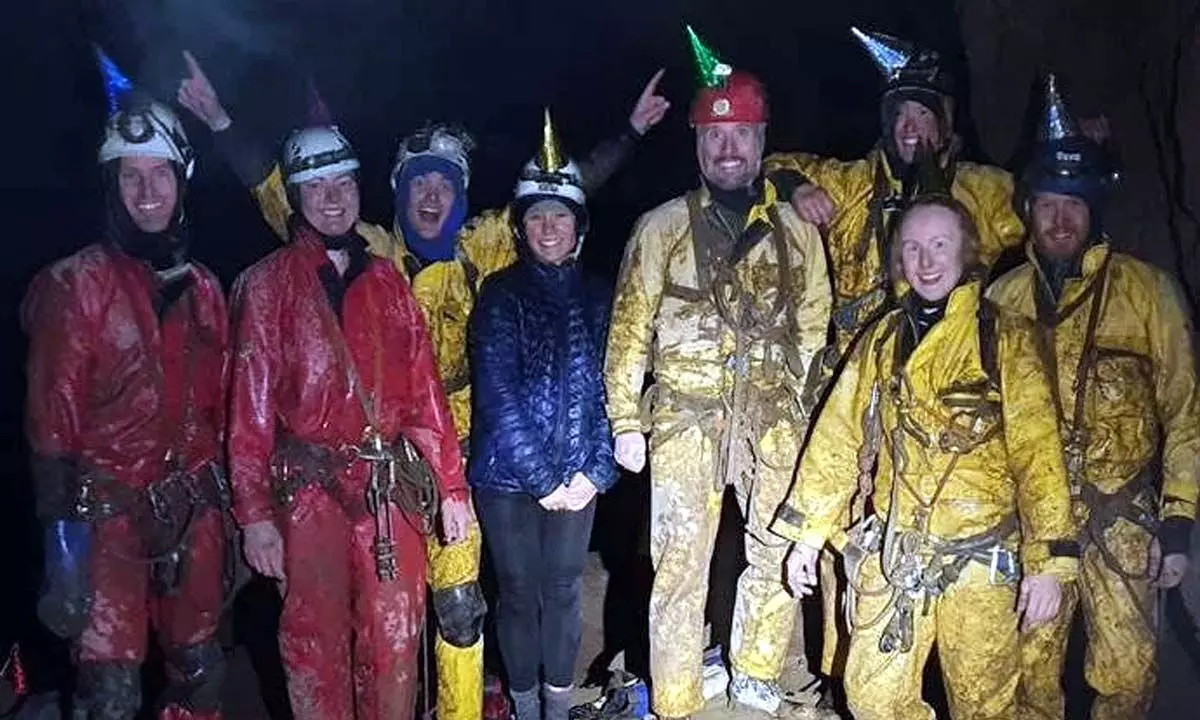Live
- Life lessons from Puranas for modern times
- Controversy erupts over revamp of Dargah
- Integrity poverty India’s main peril
- Cong plans major convention in Mandya to honour SM Krishna
- Indian Navy’s breath-taking feats captivate Vizagites
- Minister Nara Lokesh to Review Preparations for Prime Minister Modi's Visit to Visakhapatnam
- Golden Jubilee Reunion organised at Sainik School
- Hopes Spring Anew
- AP will turn a major maritime hub: CM
- APERC to hold public hearing from Jan 7
Just In
Australia's Deepest Known Cave Discovered By Researchers


Members of the group who discovered the cave. (The Southern Tasmanian Caverneers)
- The deepest known cave in Australia has been explored by cave explorers.
- A team of explorers in Tasmania's Niggly-Growling Swallet cave system in the Junee-Florentine karst region found a 401-meter-deep cave that they named Delta Variant
The deepest known cave in Australia has been explored by cave explorers. A team of explorers in Tasmania's Niggly-Growling Swallet cave system in the Junee-Florentine karst region found a 401-meter-deep cave that they named Delta Variant on Saturday.
Just a few meters separated it from its forerunner, the Niggly Cave, in terms of depth. The 14-hour descent of Delta Variant, which required months of planning, has generated controversy among the explorer groups. But those of us who conduct research on the relationship between groundwater and rocks are more fascinated by it (including in the context of caves). This aids in our understanding of how the Earth's climate has altered over millions of years as well as natural processes.
Even if the Australian environment for Delta Variant seems exciting, it is probably only a taste of the larger universe of caves; the Georgian location of the deepest known cave extends more than 2.2 kilometers into the ground. Simply put, running water slowly dissolving rock over an extended period of time is how caves emerge. They specifically develop in so-called "karst" geological formations, which also include dolomite, marble, and limestone buildings. Karst is composed of minute pieces of shell, other debris, and fossilized microorganisms that have collected over millions of years.
Small marine organisms leave behind their calcium carbonate-based "calcareous" shells long after they die. This substance is also used to make corals and other skeletonized species of fauna. This calcareous sediment accumulates to form relatively soft geological structures. A cave system eventually forms as a result of water continually dissolving the rock as it trickles through cracks in the rock. Calcium-rich rocks dissolve in naturally acidic water, unlike much harder igneous rocks.
Rain is acidic because it picks up carbon dioxide from the soils and atmosphere as it travels through the atmosphere. The rate at which karst material erodes depends on how acidic the water is. As a result, as one might expect, cave formation may be rather complicated. The type of cave that forms depends on the karst's unique composition, the water's acidity, the amount of drainage, and the surrounding geology.
Since they contain cave deposits (also known as "speleothems") like stalagmites and stalactites, caves are extremely valuable from a research standpoint. These are occasionally sharp objects that protrude upward from cave floors, droop downward from cave ceilings, or take the appearance of stunning flowstones.
Water flowing through the cave causes deposits to accumulate. These have analyzable growth rings (or layers), just like trees. They may also contain other chemical traces that the water carried and that can disclose formation-related processes. There is a lot of spatial supposition in geology. Finding out how far a cave formation extends is similar to cutting into the thickest layer of a cake, where you might not discover the same item everywhere.
Even while they might not look like much, we can use these deposits to reveal old climate-related mysteries. We can essentially expect to find them in most caves because they are a result of the interplay between rock and water during cave development. It takes a lot of skill to make it deep inside a cave network. It's quite dark, you can't use your phone because there is no reception, and you typically have to follow a guideline to find your way out. It takes time and excellent spatial exploration abilities to map the place efficiently because there may be numerous dead ends for explorers.
Although cave systems are often stable—although shallow caverns may theoretically collapse and create sinkholes, this is extremely uncommon—there is always a risk. As you abseil into darkness, you can find yourself performing awkward motions and bending and swaying in all kinds of uncomfortable ways due to the surprising geometry of caverns.
As you descend, even though the air pressure doesn't change in a hazardous way, other gases like methane, ammonia, and hydrogen sulphide can occasionally pool and present a suffocating risk. Despite everything mentioned above, people still go cave exploring, which is quite beneficial for researchers in different branches of geology even though we've come a long way.

© 2024 Hyderabad Media House Limited/The Hans India. All rights reserved. Powered by hocalwire.com






